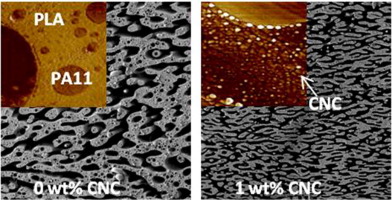当前位置:
X-MOL 学术
›
Eur. Polym. J.
›
论文详情
Our official English website, www.x-mol.net, welcomes your
feedback! (Note: you will need to create a separate account there.)
Cellulose nanocrystal in poly(lactic acid)/polyamide11 blends: Preparation, morphology and co-continuity
European Polymer Journal ( IF 5.8 ) Pub Date : 2018-01-01 , DOI: 10.1016/j.eurpolymj.2017.10.027 Vahid Heshmati , Musa R. Kamal , Basil D. Favis
European Polymer Journal ( IF 5.8 ) Pub Date : 2018-01-01 , DOI: 10.1016/j.eurpolymj.2017.10.027 Vahid Heshmati , Musa R. Kamal , Basil D. Favis

|
Abstract In this work, for the first time, cellulose nanocrystal (CNC) is incorporated into poly(lactic acid)/bio-polyamide11 (PA11) blends at different loadings through a combination of solvent dissolution, casting and melt mixing. Atomic force microscopy (AFM) and rheology analysis demonstrate an exceptional level of CNC dispersion using this technique. CNC is fed into the blends through prepared PLA/CNC or PA11/CNC mixtures via melt mixing in an internal mixer. In the PLA/PA11/CNC system, the CNC particles perfectly segregate into the PA11 phase at all compositions after mixing, irrespective of whether the PLA/CNC or the PA11/CNC mixture is used. These findings are supported by thermodynamic predictions based on interfacial energy. There is virtually no influence of CNC content on the PLA/PA11 morphology when it is in a matrix/dispersed phase form. This is attributed to the already low level of coalescence resulting from the low interfacial tension between PLA and PA11. However, when coalescence phenomena are fully maximized through the preparation of a co-continuous system (PLA/PA11 50/50), then CNC addition dramatically diminishes coalescence even at values as low as 1 wt% CNC. It is suggested that the retarded relaxation of the CNC filled PA11 domains is the main mechanism governing this coalescence reduction.
中文翻译:

聚(乳酸)/聚酰胺 11 混合物中的纤维素纳米晶体:制备、形态和共连续性
摘要 在这项工作中,纤维素纳米晶 (CNC) 首次通过溶剂溶解、浇铸和熔融混合的组合以不同的负载量掺入聚乳酸/生物聚酰胺 11 (PA11) 共混物中。原子力显微镜 (AFM) 和流变学分析表明,使用该技术可实现卓越的 CNC 分散水平。通过在密炼机中熔融混合制备的 PLA/CNC 或 PA11/CNC 混合物,将 CNC 加入混合物中。在 PLA/PA11/CNC 系统中,无论是使用 PLA/CNC 还是 PA11/CNC 混合物,CNC 颗粒在混合后的所有成分下都能完美地分离到 PA11 相中。这些发现得到了基于界面能的热力学预测的支持。当 PLA/PA11 以基质/分散相形式存在时,CNC 含量对它的形态几乎没有影响。这是由于 PLA 和 PA11 之间的低界面张力导致的聚结水平已经很低。然而,当通过制备共连续系统 (PLA/PA11 50/50) 使聚结现象完全最大化时,即使在低至 1 wt% CNC 的值下,CNC 添加也会显着减少聚结。表明 CNC 填充的 PA11 域的延迟弛豫是控制这种聚结减少的主要机制。然后即使在低至 1 wt% CNC 的值下,CNC 添加也会显着减少聚结。表明 CNC 填充的 PA11 域的延迟弛豫是控制这种聚结减少的主要机制。然后即使在低至 1 wt% CNC 的值下,CNC 添加也会显着减少聚结。表明 CNC 填充的 PA11 域的延迟弛豫是控制这种聚结减少的主要机制。
更新日期:2018-01-01
中文翻译:

聚(乳酸)/聚酰胺 11 混合物中的纤维素纳米晶体:制备、形态和共连续性
摘要 在这项工作中,纤维素纳米晶 (CNC) 首次通过溶剂溶解、浇铸和熔融混合的组合以不同的负载量掺入聚乳酸/生物聚酰胺 11 (PA11) 共混物中。原子力显微镜 (AFM) 和流变学分析表明,使用该技术可实现卓越的 CNC 分散水平。通过在密炼机中熔融混合制备的 PLA/CNC 或 PA11/CNC 混合物,将 CNC 加入混合物中。在 PLA/PA11/CNC 系统中,无论是使用 PLA/CNC 还是 PA11/CNC 混合物,CNC 颗粒在混合后的所有成分下都能完美地分离到 PA11 相中。这些发现得到了基于界面能的热力学预测的支持。当 PLA/PA11 以基质/分散相形式存在时,CNC 含量对它的形态几乎没有影响。这是由于 PLA 和 PA11 之间的低界面张力导致的聚结水平已经很低。然而,当通过制备共连续系统 (PLA/PA11 50/50) 使聚结现象完全最大化时,即使在低至 1 wt% CNC 的值下,CNC 添加也会显着减少聚结。表明 CNC 填充的 PA11 域的延迟弛豫是控制这种聚结减少的主要机制。然后即使在低至 1 wt% CNC 的值下,CNC 添加也会显着减少聚结。表明 CNC 填充的 PA11 域的延迟弛豫是控制这种聚结减少的主要机制。然后即使在低至 1 wt% CNC 的值下,CNC 添加也会显着减少聚结。表明 CNC 填充的 PA11 域的延迟弛豫是控制这种聚结减少的主要机制。










































 京公网安备 11010802027423号
京公网安备 11010802027423号